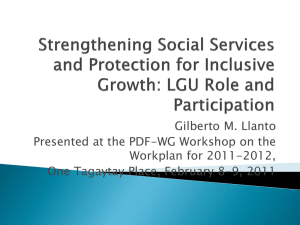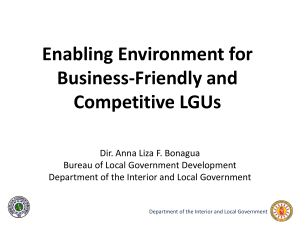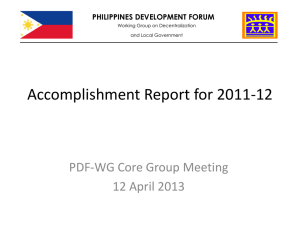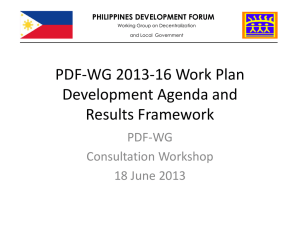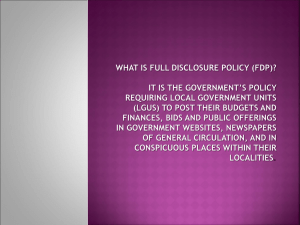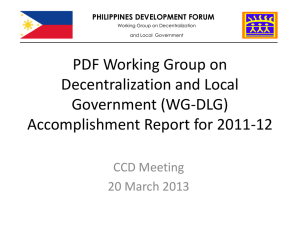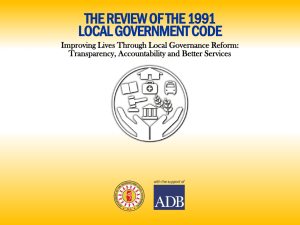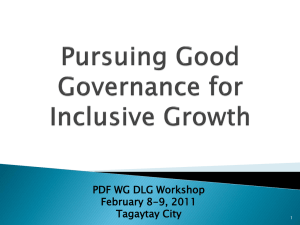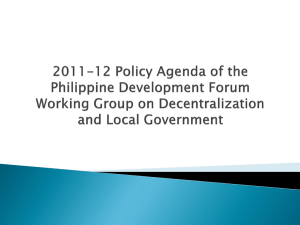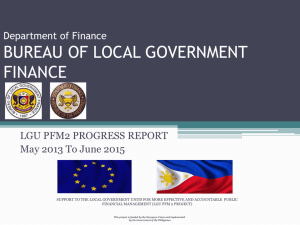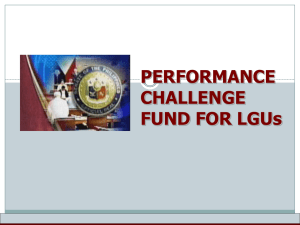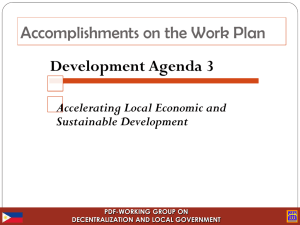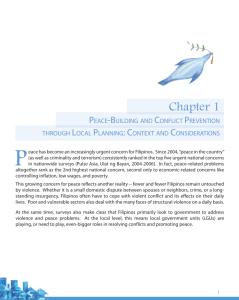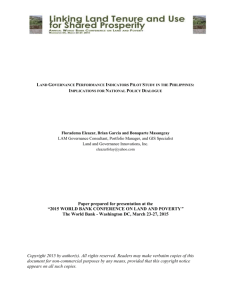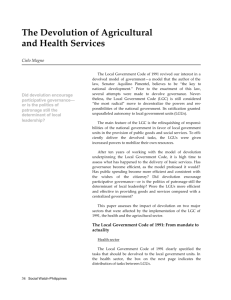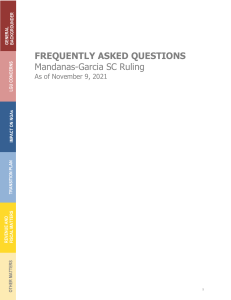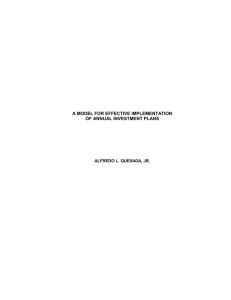Macroeconomic Challenges
advertisement
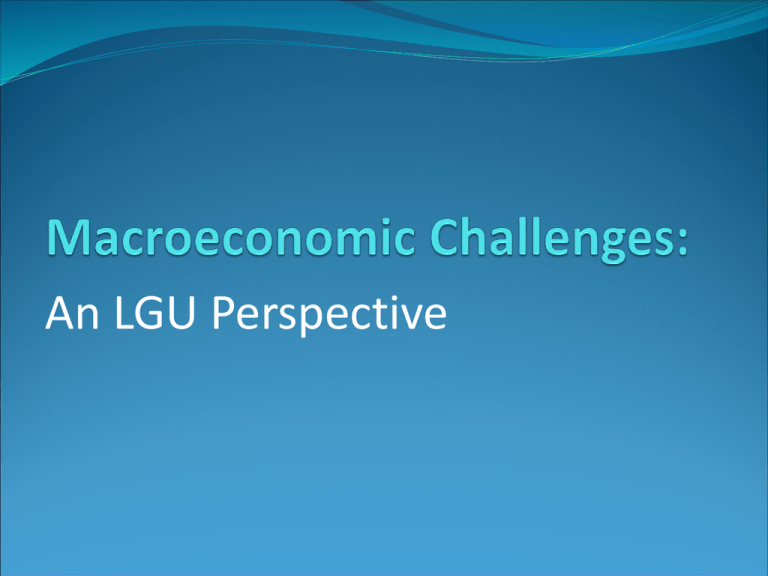
An LGU Perspective Macroeconomic Policy - Fiscal “Easing of fiscal space and achieving sustainable revenue and spending path to support physical and human capital investments and provide basic social services.” Easing of Fiscal Space LGUs contribute to the easing of fiscal space by reducing dependence on national government fiscal transfers and other assistance thereby allowing NG to use these resources to address the deficit. As an additional benefit, by relying less on NG for their funding requirements, LGUs become more fiscally autonomous fulfilling the spirit and intent of the Local Government Code of 1991. Easing of Fiscal Space LGUs can be less dependent on NG by improving their own-source revenue generation which include tax and other fees and charges and non-tax sources. Tax sources include Real Property Taxation (RPT) and Business Taxes, which are the largest sources of ownsource revenues, and non-tax sources such as income from Economic Enterprises. Easing of Fiscal Space LGUs can also explore other sources of financing such as bank credits and non-credit sources such as the issuance of debt (e.g., LGU bonds), BOT, Joint Venture partnerships with the private sector and/or other LGUs, and ODA grants. Policy Gaps In 2008, estimated local-own source revenues of local government as a share of total LGU regular revenue was 33.4%, higher than Thailand (10.9%) and Vietnam (5%). However, tax revenues accounted for only 23.5% which fell marginally from the 2006 figure of 25%. A major reason for this is that the Local Government Code seriously limits the power of the LGUs to set local taxes. Policy Gaps First, the Code fixes the tax rate of some of the taxes assigned to LGUs. These include the Special Education Fund (SEF), the Real Property Tax, and the Community Tax. Second, while LGUs have some discretion in setting tax rates in the case of other local taxes, the Code sets ceilings (or floors) on the tax rates that LGUs may impose, which in some cases appears to be low (or high) given current realities such as inflation. Policy Gaps Third, the Code mandates that tax rates can only be adjusted once every 5 years and by no more than 10%. This provision is particularly restrictive in the case of taxes such as the professional tax whose rates are specified in nominal peso terms. LGU tax administration is constrained because of low staff professional qualifications and inadequate automation of core tasks. Policy Gaps On the matter of credit financing, LGUs complain that that the concessionality of ODA-financed subloans are not brought down to them. Many LGUs have poor capacities to prepare and operate projects that would be suitable for ODA and other commercial financing. The policy and legal environment restrict LGUs from exploring other sources of financing. For example, LGUs cannot open depository accounts in private banks and LGUs cannot legally form corporations with other LGUs or private entities. Recent Developments A draft bill amending Book II of the Local Government Code of 1991 (Taxation) has been endorsed by the LGU Leagues and the DILG to the Congress. Studies have been completed on LGU Access to ODA financing and credit financing. Executive Order 809 has been issued allowing first tier LGUs to borrow from multilateral financing institutions with a sovereign guarantee. A study on improving LGU exercise of their corporate powers has been completed. Some Policy Recommendations Conduct an advocacy campaign to the Congress for the passage of the Book II amendments of the Local Government Code of 1991. Review the pricing and terms under which ODA is provided to GFIs. Develop a more transparent system for determining who should benefit from the concessionality embedded in ODA. Continue to build capacity among LGUs for tax administration and the preparation and management of credit and debt financed projects. Some Policy Recommendations Draft and implement policy issuances that would clarify and encourage joint venture arrangement among LGUs and between LGUs and the private sector entities. Study marked-based measures to reinvigorate LGU bond floatation. Review the implementation of Executive Order 809 in order to effect pilot testing in the near future. Review the policy for selectively allowing LGUs to open depository accounts in private banks. Achieving sustainable revenue and spending path LGUs support the national effort for a sustainable revenue and spending path by ensuring that the same is emulated at the local level. This is achieved through well-rationalized, prudent, efficient and harmonized planning, budget preparation, revenue generation and expenditure management. Policy Gaps Although revenue management and budget reporting have been improved, linking these to planning an to each other is still weak for many LGUs. The integrity of local budgeting is distorted by poor revenue estimates during budget formulation. Budget formulation and execution, planning and revenue generation at the local level is not linked to performance outcomes. There is also a lack of performance measures that adequately track Public Financial Management (PFM) at the local level. Policy Gaps These is a lack of incentive systems for good PFM performance. There is a lack of sanctions for poor performance in local administration. Some sources of revenues such as the Special Education Fund are not effectively utilized due to a restrictive interpretation of existing law on its use. Recent Developments A study has been completed on improving the use of the Special Education Fund and a draft issuance based on the study’s recommendations is being circulated. Studies have been completed on issues related to personal expenditures and the management of surpluses and deficits in LGUs. The Performance Challenge Fund (PCF) has been pilot tested in 2010 and will be fully implemented in 2011 with a initial fund of P500 million. The ICC approved the Performance-Based Incentive Policy in 2010 which will lead the way for the Performance-Based Grant System. Recent Developments The Executive has approved a national PFM roadmap. In support of JMC 2007-1, technical assistance has been provided and continues to be provided to the BLGF for the improvement of the Statement of Receipts and Expenditures. In support of JMC 2007-1, technical assistance on local planning has been provided to both the DILG and the NEDA for planning at all LGU levels. In support of JMC 2007-1, technical assistance for key areas of the DBM’s UBOM have and continues to be provided. Recent Developments Technical assistance is being provided for the finalization of the implementation of the Competency Certification for Local Treasurers. A law has been passed requiring assessors to pass a professional licencing examination. Policy Recommendations Implement the Competency Certification System for Local Treasurer in order to professionalize the service. Implement plan-budget linkage by providing financial incentives in the form of loan, loans and grants, and grants for achievement of budget targets and outcomes. Encourage good performance in PFM by providing a performance-grant that scales up performance. Review the PFM Roadmap for gaps in assistance not currently provided or in the pipeline. Raymund C. Fabre ADB TA 7451
